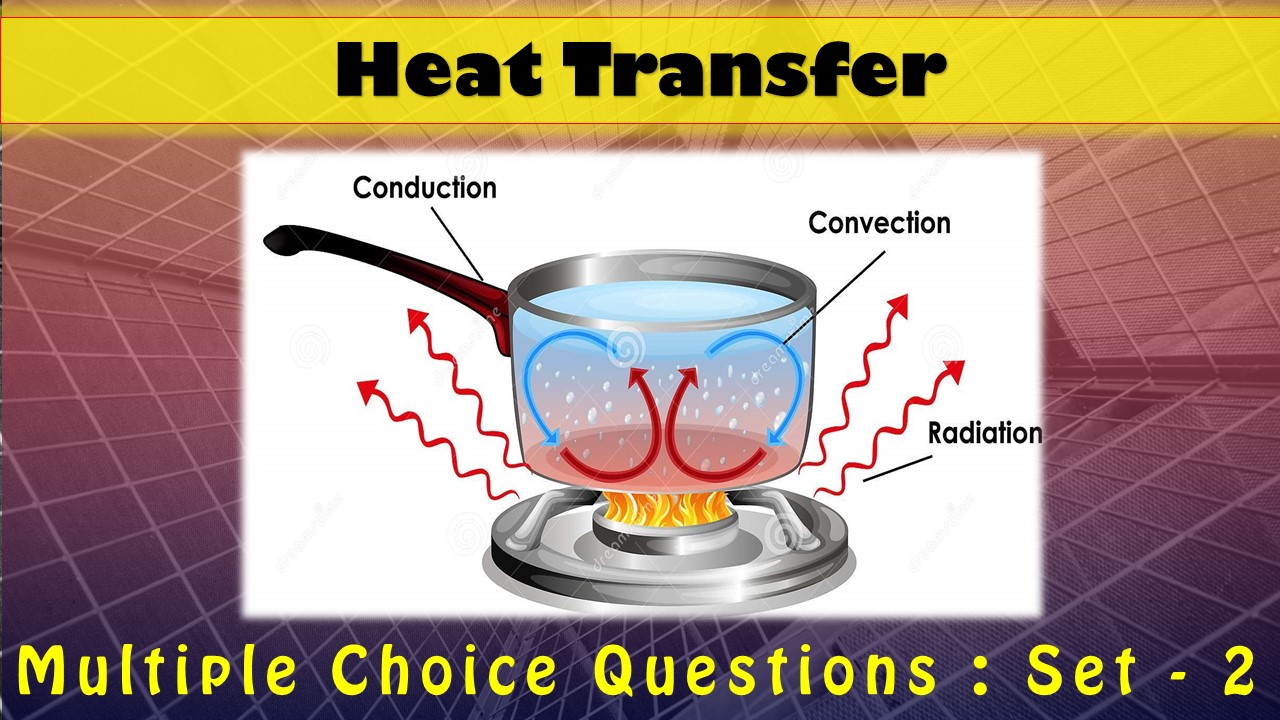MCQ Questions Mechanical Engineering Heat Transfer
The interviewer is almost as nervous as the candidate in most interviews. You might wonder if you look confident enough, if you will hire the right person, or if you are asking the right engineering interview questions. The last question is arguably the most crucial part to worry about when you’re interviewing candidates.
MCQ Questions Mechanical Engineering Heat Transfer - Set - 5
Question 1:
In heat exchangers, degree of approach is defined as the difference between temperatures of
(a) cold water inlet and outlet
(b) hot medium inlet and outlet
(c) hot medium outlet and cold water inlet
(d) hot medium outlet and cold water outlet
Correct Answer – (D)
Question 2 :
A non-dimensional number generally associated with natural convection heat transfer is
(a) Grashoff number
(b) Nusselt number
(c) Weber number
(d) Prandtl number
Correct Answer – (A)
Question 3 :
A grey body is one whose absorptivity
(a) varies with temperature
(b) varies with wavelength of the incident ray
(c) is equal to its emissivity
(d) does not vary with temperature and. wavelength of the incident ray
Correct Answer – (C)
Question 4 :
Reynolds number (RN) is given by (where h = Film coefficient, l = Linear dimension, V = Velocity of fluid, k = Thermal conductivity, t = Temperature, ρ = Density of fluid, cp = Specific heat at constant pressure, and μ = Coefficient of absolute viscosity)
(A) RN = hl/k
(B) RN = μ cp/k
(C) RN = ρ V l /μ
(D) RN = V²/t.cp
Correct Answer – (C)
Question 5 :
Fourier’s law of heat conduction is (where Q = Amount of heat flow through the body in unit time, A = Surface area of heat flow, taken at right angles to the direction of heat flow, dT = Temperature difference on the two faces of the body, dx = Thickness of the body, through which the heat flows, taken along the direction of heat flow, and k = Thermal conductivity of the body)
(A) k. A. (dT/dx)
(B) k. A. (dx/dT)
(C) k. (dT/dx)
(D) k. (dx/dT)
Correct Answer – (A)
MCQ Questions Mechanical Engineering Heat Transfer
Question 6:
LMTD in case of counter flow heat exchanger as compared-to parallel flow heat exchanger is
(a) higher
(b) lower
(c) same
(d) depends on the area of heat exchanger
Correct Answer – (A)
Question 7:
Two balls of same material and finish have their diameters in the ratio of 2 : 1 and both are heated to same temperature and allowed to cool by radiation. Rate of cooling by big ball as compared to smaller one will be in the ratio of
(a) 1 :1
(b) 2: 1
(c) 1 : 2
(d) 4 : 1
Correct Answer – (C)
Question 8:
Sensible heat is the heat required to
(A) Change vapour into liquid
(B) Change liquid into vapour
(C) Increase the temperature of a liquid of vapour
(D) Convert water into steam and superheat it
Correct Answer – (C)
Question 9:
When heat is transferred from hot body to cold body, in a straight line, without affecting the intervening medium, it is referred as heat transfer by
(A) Conduction
(B) Convection(
C) Radiation
(D) Conduction and convection
Correct Answer – (C)
Question 10:
When heat is transferred from one particle of hot body to another by actual motion of the heated particles, it is referred to as heat transfer by
(A) Conduction
(B) Convection
(C) Radiation
(D) Conduction and convection
Correct Answer – (A)
- NCERT Solutions Class 11 Physics Chapter 1 : Physical world
- NCERT Solutions Class 11 Physics Chapter 2 : Units And Measurements
- NCERT Solutions Class 11 Physics Chapter 3 : Motion In A Straight Line
- NCERT Solutions Class 11 Physics Chapter 4 : Motion In A Plane
- NCERT Solutions Class 11 Physics Chapter 5 : Laws of Motion
- NCERT Solutions Class 11 Physics Chapter 6 : Work Energy Power
- NCERT Solutions Class 11 Physics Chapter 7 : Rotational-Motion
- NCERT Solutions Class 11 Physics Chapter 8 : Gravitation
- NCERT Solutions Class 11 Physics Chapter 9 : Mechanical Properties of Solids
- NCERT Solutions Class 11 Physics Chapter 10 : Mechanical Properties of Fluids
- NCERT Solutions Class 11 Physics Chapter 11 : Thermal Properties of Matter
- NCERT Solutions Class 11 Physics Chapter 12 : Thermodynamics
- NCERT Solutions Class 11 Physics Chapter 13 : Kinetic Theory
- NCERT Solutions Class 11 Physics Chapter 14 : Oscillations
- NCERT Solutions Class 11 Physics Chapter 15 : Waves
Multiple Choice Questions for Competitive Exams
- MCQ Questions Class 11 Chemistry Environmental Chemistry with Answers
Set -1 Set -2 Set -3 Set -4 Set -5 - MCQ Questions Class 11 Chemistry Hydrocarbons with Answers
Set -1 Set -2 Set -3 Set -4 Set -5 - MCQ Questions Class 11 Chemistry Organic Chemistry with Answers
Set -1 Set -2 Set -3 Set -4 Set -5 - MCQ Questions Class 11 Chemistry The p Block Elements with Answers
Set -1 Set -2 Set -3 Set -4 Set -5 - MCQ Questions Class 11 Chemistry The s Block Elements with Answers
Set -1 Set -2 Set -3 Set -4 Set -5 - MCQ Questions Class 11 Chemistry Hydrogen with Answers
Set -1 Set -2 Set -3 Set -4 Set -5




